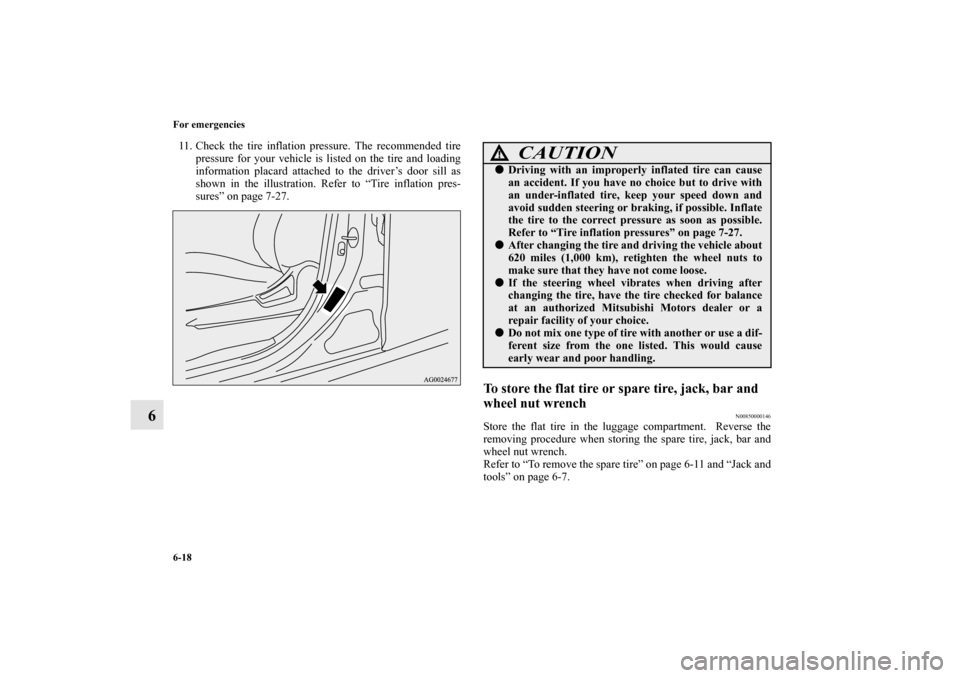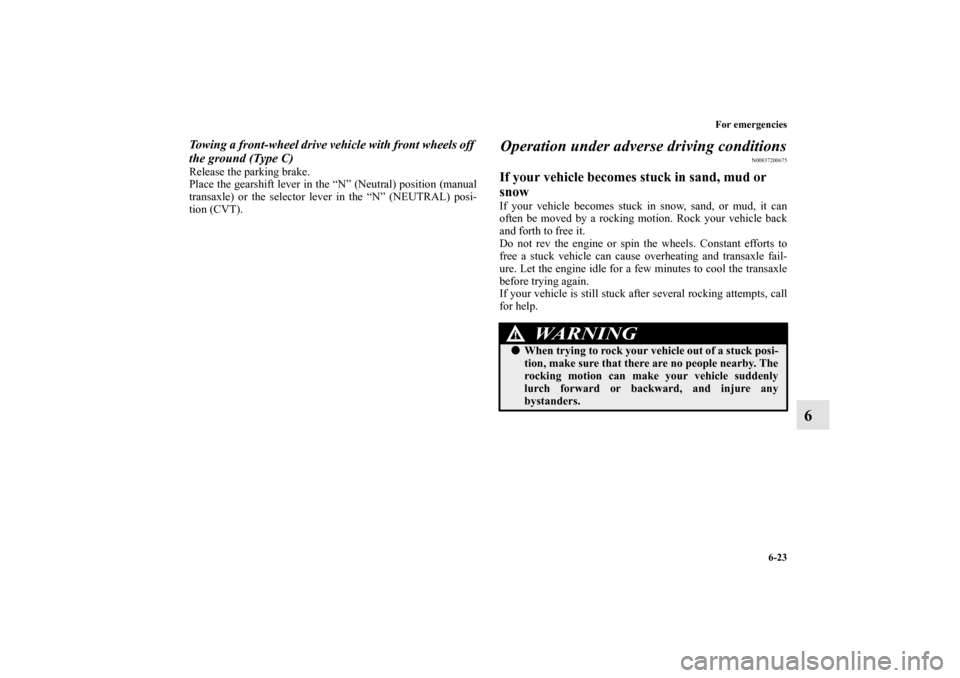Page 493 of 602

6-18 For emergencies
6
11. Check the tire inflation pressure. The recommended tire
pressure for your vehicle is listed on the tire and loading
information placard attached to the driver’s door sill as
shown in the illustration. Refer to “Tire inflation pres-
sures” on page 7-27.
To store the flat tire or spare tire, jack, bar and
wheel nut wrench
N00850000146
Store the flat tire in the luggage compartment. Reverse the
removing procedure when storing the spare tire, jack, bar and
wheel nut wrench.
Refer to “To remove the spare tire” on page 6-11 and “Jack and
tools” on page 6-7.
CAUTION
!�Driving with an improperly inflated tire can cause
an accident. If you have no choice but to drive with
an under-inflated tire, keep your speed down and
avoid sudden steering or braking, if possible. Inflate
the tire to the correct pressure as soon as possible.
Refer to “Tire inflation pressures” on page 7-27.�After changing the tire and driving the vehicle about
620 miles (1,000 km), retighten the wheel nuts to
make sure that they have not come loose.�If the steering wheel vibrates when driving after
changing the tire, have the tire checked for balance
at an authorized Mitsubishi Motors dealer or a
repair facility of your choice.�Do not mix one type of tire with another or use a dif-
ferent size from the one listed. This would cause
early wear and poor handling.
BK0120400US.book 18 ページ 2010年5月12日 水曜日 午前10時50分
Page 498 of 602

For emergencies
6-23
6
Towing a front-wheel drive vehicle with front wheels off
the ground (Type C)Release the parking brake.
Place the gearshift lever in the “N” (Neutral) position (manual
transaxle) or the selector lever in the “N” (NEUTRAL) posi-
tion (CVT).
Operation under adverse driving conditions
N00837200675
If your vehicle becomes stuck in sand, mud or
snowIf your vehicle becomes stuck in snow, sand, or mud, it can
often be moved by a rocking motion. Rock your vehicle back
and forth to free it.
Do not rev the engine or spin the wheels. Constant efforts to
free a stuck vehicle can cause overheating and transaxle fail-
ure. Let the engine idle for a few minutes to cool the transaxle
before trying again.
If your vehicle is still stuck after several rocking attempts, call
for help.
WA R N I N G
!�When trying to rock your vehicle out of a stuck posi-
tion, make sure that there are no people nearby. The
rocking motion can make your vehicle suddenly
lurch forward or backward, and injure any
bystanders.
BK0120400US.book 23 ページ 2010年5月12日 水曜日 午前10時50分
Page 500 of 602
For emergencies
6-25
6
On a bumpy or rutted road�Drive as slow as possible when driving on bumpy, rutted
roads or over potholes.
CAUTION
!�Driving on bumpy, rutted roads or over potholes can
damage the tires and wheels.
Wheels with low-profiles tires or under-inflated tires
are especially at risk for damage.
BK0120400US.book 25 ページ 2010年5月12日 水曜日 午前10時50分
Page 503 of 602

7-2 Vehicle care and maintenance
7Service precautions
N00937300332
Taking regular care of your vehicle will preserve its value and
appearance as long as possible.
You can do some of the maintenance work yourself, and the
rest should only be performed by an authorized Mitsubishi
Motors dealer or a repair facility of your choice.
If you discover a malfunction or other problem, have it cor-
rected by an authorized Mitsubishi Motors dealer or a repair
facility of your choice.
This section describes the maintenance inspections that you
can do yourself, if you so desire. Follow the instructions and
precautions for each procedure.
Have you purchased the Mitsubishi Motors Diamond Care Pro-
tection Plan? The Plan supplements your new vehicle warran-
ties. See your authorized Mitsubishi Motors dealer for details.
WA R N I N G
!�When checking or servicing the inside of the engine
compartment, be sure the engine is stopped and has
had a chance to cool down.�If you need to work in the engine compartment with
the engine running, be especially careful that your
clothing, hair, etc. does not get caught in the fan,
drive belts, or other moving parts.�The fan can turn on automatically even if the engine
is not running. Turn the ignition switch to the
“LOCK” position or put the operation mode in OFF
to be safe while you work in the engine compart-
ment.�Do not smoke or allow open flames around fuel or
the battery. The fumes are flammable.
�Be extremely careful when working around the bat-
tery. It contains poisonous and corrosive sulfuric
acid.�Do not get under your vehicle while it is on a jack.
Always use properly rated automotive jack stands.�Handling your vehicle’s parts and materials in the
wrong way can injure you. Ask an authorized Mit-
subishi Motors dealer or a repair facility of your
choice if you have questions.
WA R N I N G
!
BK0120400US.book 2 ページ 2010年5月12日 水曜日 午前10時50分
Page 504 of 602

Vehicle care and maintenance
7-3
7 Catalytic converter
N00937400447
The catalytic converter requires you to use unleaded fuel only.
Leaded gasoline will destroy the emission-control effective-
ness of the converter.
Normally, the catalytic converter does not require maintenance.
However, it is important to keep the engine properly tuned for
the converter to continue to work properly.To reduce the possibility of catalytic converter damage:
�Use UNLEADED GASOLINE ONLY of the type of rec-
ommended in “Fuel selection”.
�Do not drive with an extremely low fuel level. Running
out of gas could damage the catalytic converter.
�Do not try to start the engine by pushing or towing the
vehicle. If the battery is weak or run down, use jumper
cables to properly start the engine.
�Do not idle the engine with any spark plug wires discon-
nected or removed, such as when performing diagnostic
tests.
�Do not idle the engine for a long time if it is idling
roughly or otherwise obviously malfunctioning.
�To prevent the catalytic converter from being damaged
from unburned gas, do not race the engine when stopping
the engine.
�Stop driving the vehicle if you think the performance is
noticeably low, or the engine has a malfunction such as
with the ignition, etc. If you are not able to stop driving
immediately, slow down and drive for only a short time.
Have your vehicle checked at an authorized Mitsubishi
Motors dealer or a repair facility of your choice as soon as
possible.
�In unusual situations involving major engine problems, a
burning odor may indicate severe and abnormal catalytic
converter overheating. If this occurs, stop in a safe place,
shut the engine off and let the vehicle cool. Once the
engine is cool, immediately take your vehicle to a dealer
or a repair facility of your choice for service.
CAUTION
!�Damage to the catalytic converter can result if your
vehicle is not kept in proper operating condition. If
the engine malfunctions or misfires, or if your vehi-
cle performance suffers, have it serviced promptly.
Running your vehicle when it is overheated may
result in damage to the converter and vehicle.
WA R N I N G
!�Do not park or run your vehicle in areas where com-
bustible materials such as dry grass or leaves can
come in contact with a hot exhaust, since a fire could
occur.�Do not put undercoat paint on the catalytic con-
verter.
BK0120400US.book 3 ページ 2010年5月12日 水曜日 午前10時50分
Page 505 of 602
7-4 Vehicle care and maintenance
7Engine hood
N00937500477
To openUse the engine hood release lever (located under the instrument
panel near the driver’s door) to unlock the engine hood.
Pull the lever toward you to release the engine hood latch.Release the lever and lift the engine hood.
NOTE�To prevent damage to the engine hood and wipers, make
sure the wipers are at resting position when you open the
engine hood.
WA R N I N G
!�Never use the release lever to unlatch the engine
hood while the vehicle is in motion.�Do not drive your vehicle unless the engine hood is
locked.
BK0120400US.book 4 ページ 2010年5月12日 水曜日 午前10時50分
Page 506 of 602
Vehicle care and maintenance
7-5
7
Support the engine hood with the hood prop. Insert the hood
prop securely in the opening under the hood marked with an
arrow.
To closeUnlatch the prop from the engine hood and put it back in its
retainer.
Slowly lower the engine hood about 8 inches (20 cm), then let
it drop from its own weight.
CAUTION
!�Always insert the support prop into the hole spe-
cially made for it. Propping the engine hood at any
other place could cause the prop to slip out and lead
to an accident.�The hood prop can fall out if the hood is lifted by a
strong wind.
CAUTION
!�Be careful not to trap your hands or fingers when
closing the engine hood.�Make sure the engine hood is firmly closed before
driving.
If you drive without the engine hood completely
closed, it could open up while driving.
BK0120400US.book 5 ページ 2010年5月12日 水曜日 午前10時50分
Page 517 of 602

7-16 Vehicle care and maintenance
7Wa s h e r f l u i d
N00938600299
The windshield and rear window washer fluid reservoir is in
the engine compartment.
Check the washer fluid level at regular intervals and add
washer fluid to reservoir if necessary.
Open the reservoir cap and check the fluid level with the dip-
stick.
When freezing weather is anticipated, flush out the water in the
reservoir by operating the pump. Fill the reservoir with wind-
shield antifreeze (not radiator antifreeze), and operate the sys-
tem for a few seconds to flush out the residual water.
Brake fluid/Clutch fluid
(if so equipped)
N00938700245
The brake fluid and the clutch fluid share the reservoir tank.To check the fluid levelThe fluid level must be between the “MAX” and “MIN” marks
on the reservoir.
The fluid level falls slightly with wear of the brake pads, but
this does not indicate any abnormality.
The fluid in the master cylinder should be checked when doing
other work under the engine hood. The brake system should
also be checked for leaks at the same time.
If the fluid level falls markedly in a short length of time, it indi-
cates leaks from the brake system.
If this occurs, have the vehicle checked by an authorized Mit-
subishi Motors dealer or a repair facility of your choice.
FULL
EMPTY
MAX
MIN
BK0120400US.book 16 ページ 2010年5月12日 水曜日 午前10時50分